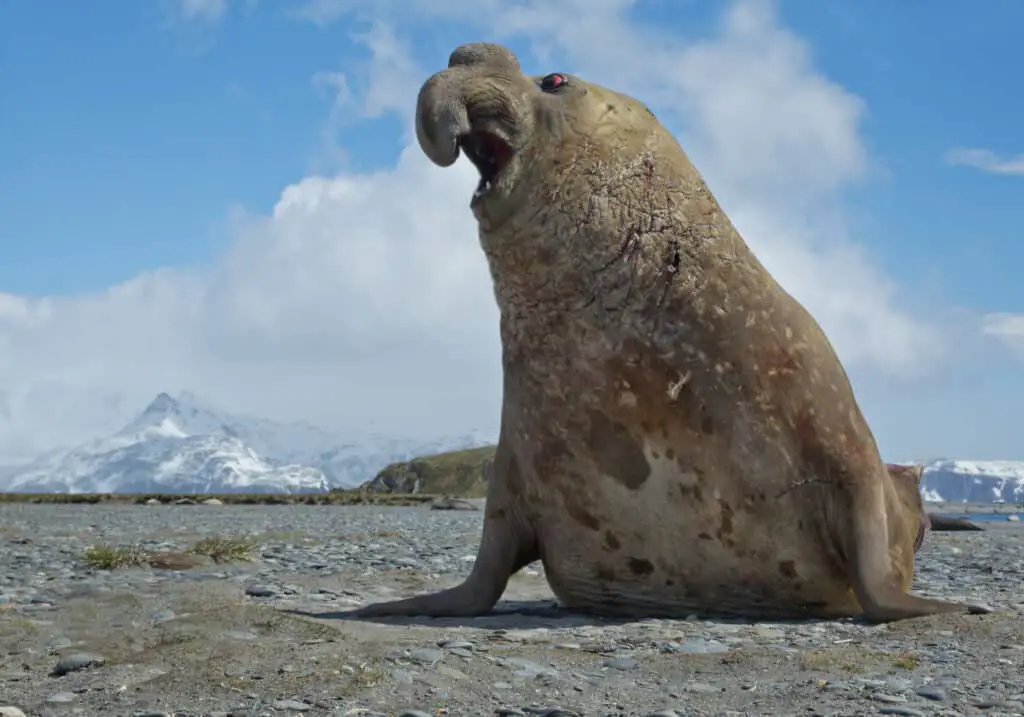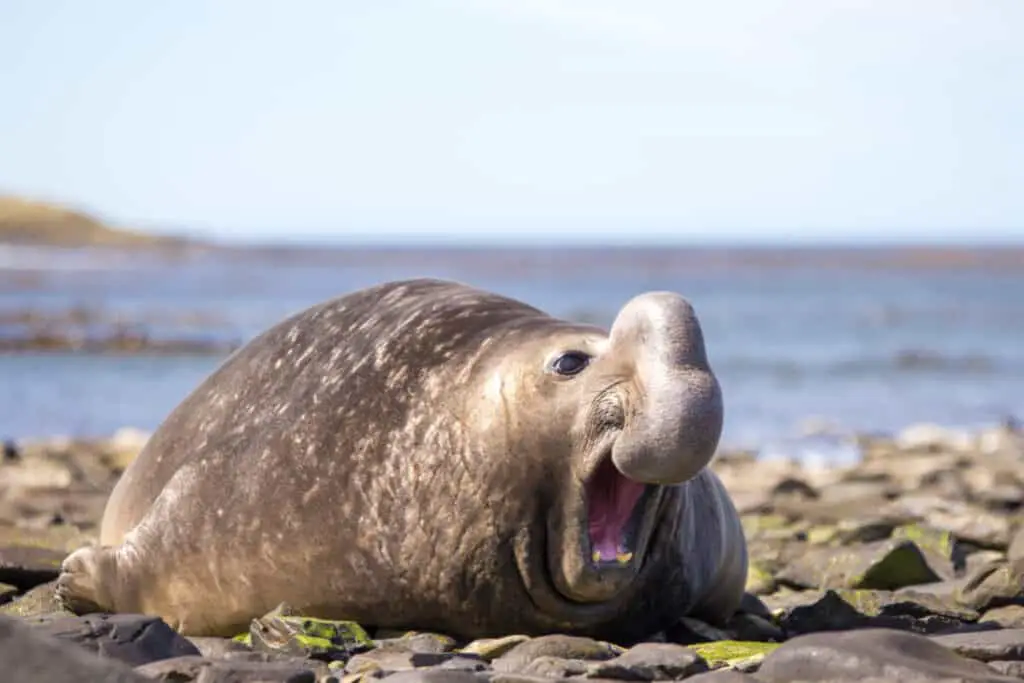The Elephant Seal is a marine mammal belonging to the phocid family. It is one of the largest seals in the world, with males weighing up to 4 tons and measuring over 20 feet long.
The species has two distinct subtypes: Northern Elephant Seals are found along coastal regions from California to Alaska, while Southern Elephant Seals inhabit sub-Antarctic and Antarctic waters.
These charismatic creatures have fascinated researchers for decades due to their impressive size and unique behaviors. They spend most of their lives at sea, but return to land annually for breeding and molting.
During mating season, male elephant seals engage in fierce battles for access to females, often resulting in bloody wounds and scars. Additionally, their blubber layer helps them survive extended periods without food during migration and molting seasons.
In this article, we will explore key aspects of these fascinating animals including habitat range, physical characteristics, social behavior, diet, and conservation status.

Habitat Range And Distribution
Despite its name, the elephant seal is not closely related to elephants but belongs to the family Phocidae or true seals. These marine mammals are found in sub-Antarctic and Antarctic waters, as well as along the coast of California and Mexico.
While these regions serve as their primary habitat range, elephant seals have been known to migrate long distances through open ocean waters. Migration patterns vary depending on the sex and age of the individual.
Males tend to travel further from breeding colonies than females do, while juveniles move more often than adults. During the breeding season, adult males establish territories on beaches near large groups of females called harems.
Females give birth within a few days of arriving at these sites and nurse their pups for several weeks before returning to sea. After mating takes place, males leave the colony and begin their migration journey back into deeper waters.
Circle of Life: The Lifecycle of Seals
Physical Characteristics And Adaptations
The elephant seal is a marine mammal that can weigh up to 4,500 kg and grow as long as 6 meters. These seals are characterized by their large size, elongated snouts, deep brown fur, and distinctively shaped proboscis.
They have a thick layer of blubber insulation underneath the skin that helps them regulate body temperature in cold waters. This adaptation also allows them to survive for extended periods without food while on land during the molting process.
During the molting process, elephant seals shed their old skin and hair all at once. The shedding starts from the head down to the tail and takes around three weeks to complete. Molting occurs annually, usually after breeding season when they spend several months out of water on beaches along with other members of their colony.
During this time, they fast until the molt is complete and then return to sea to feed again. Overall, these physical characteristics and adaptations allow elephant seals to thrive in harsh marine environments where temperatures fluctuate greatly throughout the year.
Social Behavior And Mating Rituals
Elephant seals exhibit a clear dominance hierarchy during the breeding season.
Males establish territories on beaches and engage in aggressive interactions with other males to gain access to females.
The dominant male, also known as the beach master, is able to mate with multiple females while subordinate males may only be allowed access to one or two females.
The breeding strategies of elephant seals are heavily influenced by this dominance hierarchy.
Male elephant seals invest significant energy into defending their territory and fighting off rivals, often resulting in injuries that can impact their ability to reproduce successfully.
Females tend to prefer mating with dominant males due to their higher genetic quality and increased likelihood of producing healthy offspring.
However, some female elephant seals have been observed engaging in extra-pair copulations with non-dominant males, possibly as a way of obtaining better genes for their offspring without risking harm from an aggressive mate.
Diet And Feeding Habits
The elephant seal’s diet and feeding habits are a testament to its predatory prowess. Similar to a skilled hunter, the elephant seal employs several strategies when it comes to catching prey.
These marine mammals have been known to dive up to 2,100 meters deep into the ocean in search of their next meal. The elephant seal’s diving ability is aided by its large body size and high oxygen storage capacity that allows them to remain underwater for extended periods.
Prey preferences vary depending on the season, with squid being a popular choice during summer months. During winter, however, they tend to favor fish species such as hake and lanternfish.
When hunting, elephant seals use their exceptional eyesight and hearing abilities to locate prey from afar before using their powerful jaws and teeth to capture and consume their target. Overall, these creatures are highly efficient hunters who have adapted well to life in the open sea thanks to their impressive suite of hunting techniques.
With an array of effective hunting tactics at their disposal, there is no doubt that elephant seals are formidable predators in the wild. Their diverse prey preferences coupled with innovative hunting strategies make them particularly successful at finding food in even the most challenging environments.
As such, it is clear that this species has evolved over time into one of nature’s most impressive examples of aquatic excellence.
Threats And Conservation Status
The elephant seal, though a formidable predator in the ocean, faces several threats that have affected its population size.
One of these is overfishing impact; as fish populations decline due to commercial fishing activities and climate change effects, elephant seals are struggling to find enough food to sustain themselves. This issue has been especially pronounced in areas where elephant seals rely on krill for their diet, which has become scarce due to rising sea temperatures.
Another significant threat to the survival of elephant seals is climate change. As global temperatures rise, glaciers and ice sheets melt at an alarming rate, causing sea levels to rise and impacting coastal habitats where many pinnipeds live and breed.
Additionally, changes in temperature and rainfall patterns can alter the availability of prey species such as squid or sardines that form a vital part of the diets of many marine mammals like elephant seals.
The cumulative effect of these factors means that elephant seals face severe challenges when it comes to maintaining healthy populations into the future.
Research And Future Directions
Like the deep and vast oceans that they inhabit, elephant seals remain mysterious creatures to this day. Despite their massive size and distinctive appearance, much of their biology and behavior remains unknown.
However, ongoing research efforts have shed light on some aspects of these marine mammals that were once shrouded in mystery. Current research on elephant seals has focused primarily on population trends, as these animals are considered vulnerable due to hunting practices in the past.
Scientists have been monitoring breeding colonies and tracking individual seals using satellite tags to gather data about movement patterns and feeding habits. These studies have revealed important information about migration routes, foraging ecology, and reproductive success rates among different populations of elephant seals around the world.
Such insights can help conservationists develop effective strategies for protecting these magnificent animals from further threats. As our understanding of elephant seal biology continues to evolve through current research, it is clear that there is still much we do not know about these fascinating creatures.
Nevertheless, by closely monitoring population trends and conducting rigorous scientific investigations into their behaviors and habitats, we may be able to safeguard them against future threats so that they can continue to thrive in the wild for generations to come.

Conclusion
The elephant seal, a marine mammal with exceptional adaptations, inhabits the frigid waters and beaches of the Southern Hemisphere.
These impressive creatures can weigh up to 4 tons and dive to depths exceeding 7,000 feet for over an hour at a time.
Their social behavior includes competitive and violent mating rituals that contribute to their survival in harsh environments.
Despite their enormous size and strength, these animals are threatened by human activities such as fishing practices, pollution, climate change, and habitat destruction.
Conservation efforts have been put into place to protect them from these threats.
Future research on the ecology and physiology of elephant seals will aid in further understanding this species’ unique adaptations and conservation needs.
In conclusion, while the elephant seal’s physical characteristics may seem intimidating to some observers; its existence is delicate due to numerous environmental factors.
The challenges faced by this remarkable species remind us of our shared responsibility towards preserving natural habitats for all living beings.
By continuing research into their lives and behaviors alongside protecting their habitats from harmful influences we can ensure that future generations can appreciate the awe-inspiring nature of these fascinating creatures.

